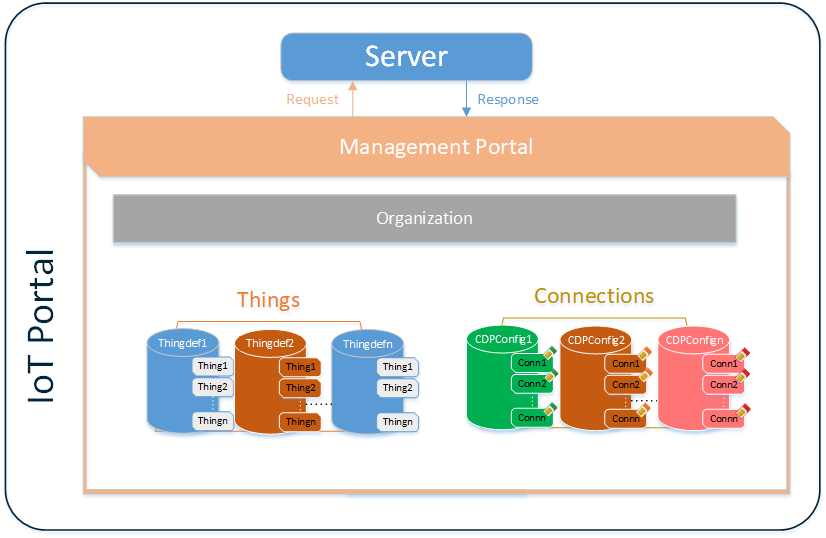Architecture of deviceWISE Cloud
The deviceWISE Cloud data model's major items and their relationships are described below.

An organization is the top level container. The Thing definitions, Things, Access Tokens and Roles are part of an organization. Sub-organizations are created to further partition the items in your IoT solution. For example, An organization is defined to represent a company, and sub-organizations are defined for each of the company's plant locations. A sub-organization's usage information is rolled up to its parent organization. Each of the sub-organizations within an organization must have a unique name.
A thing definition models the attributes, alarms, properties, methods, tunnels, presentation information, and other characteristics of a particular type of item that is a portion of your IoT solution.
Things are instances of a Thing definition. Things inherit their characteristics from their thing definition.
A thing is a logical item in the sense that it is defined with the characteristics that are important to your IoT solution and your application logic. It may not have all of the characteristics of an actual physical item.
- Each gateway connected to the IoT portal is an example of a Things.
- Each application connected to the IoT portal, using the IoT Portal API Reference Guide, is another example of a Things.
Things are the primary items that associate data to the items that make up your IoT solution (gateways, sensors, devices, assets, programs, cellular modules, and so on).
Every person using the IoT portal has a user (or account) defined for them.
- A user can be a member of multiple organizations.
- A user is assigned a role in each organization
- A user assigned an organization administrator role in an organization has the same organization administrator role in all of the organization's sub-organizations.
Roles are used to define access rights (view, modify, execute, and other actions.) to items. Users are assigned a role in an organization, and have different roles in different organizations.
Applications are assigned a role in the organization that they belong to.
An App Token is an item that is used to represent a software application that connects to the IoT portal.
Examples of applications include: Asset
Gateway and Enterprise Gateway software
products, external applications using the
IoT Portal API
Reference Guide
An App Token is defined with a role, license information, and auto registration information.
The application
token is referenced by a gateway, by
an external application
Main Features
- Connectivity
- MQTT Interface (TR50 compliant)
Connect an MQTT client to the IoT Portal either unencrypted or with MQTT over SSL (SSLv3 or TLS1+) for improved security. This is the preferred protocol to use for real-time or near-real-time performance. It is the only interface that supports subscribing to live feeds of data coming from devices. - HTTP(S) Interface (TR50
compliant)
A JSON over HTTP interface is supplied that conforms to the TR50 standard. This interface tends to be the preferred interface for web applications.HTTPS requires SSLv3 or TLS1+
- UDP Receiver (TR50 compliant)
Send UDP messages to the IoT Portal, this is ideal when using a platform that does not support TCP - LWM2M over CoAP
LWM2M over CoAP is a protocol that enables communication between a LWM2M server and a LWM2M client, which is located in the LWM2M device. The deviceWISE Cloud connects the LWM2M devices and provides all the device management features. - CloudSMS
Send and receive SMS messages with ease to automate provisioning or notify your users when alarms occur.
- MQTT Interface (TR50 compliant)
- Main Services
- Device Management
- Connection Management
- Provisioning Interfaces
- Alert Notifications
- Rating Engine
- Reporting Engine
- License Management
- Security Management
- Management Portal
- Developer Forum
- Support Cases
- Online Help
- Data-at-Rest
Built-in data warehouse for storing your device's sensor data, locations, alarms, etc. - Data-in-Transit
Native integration with 3rd party enterprise systems from industry leading vendors such as IBM, Oracle, and SAP.